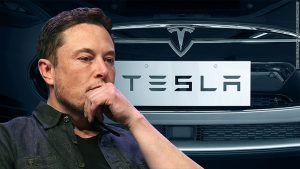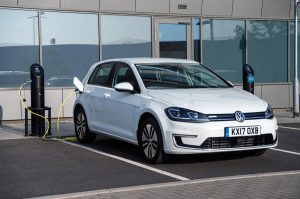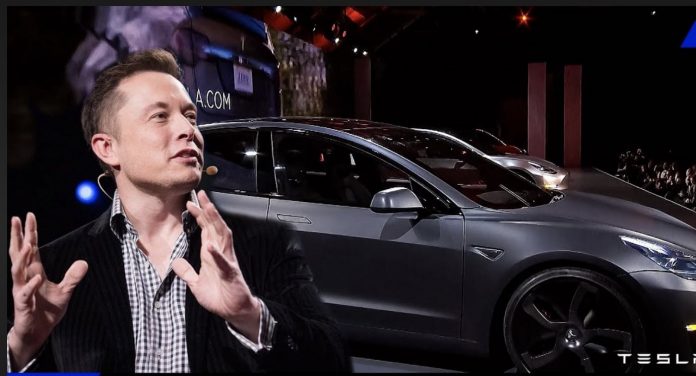Elon just admitted something which is getting very little coverage – and no explanation.
He announced that Tesla will no longer be selling the “affordable” $35,000 Model 3 he promised would be Tesla’s first mass-market electric car. Like so many of Elon’s promises, that one’s out the window, too.
The price of the least expensive Tesla just rose to $39,000. Well, technically $38,990 – to make it go down easier.
That’s still a $4k decrease in “affordability” – and a reality check.
Elon is admitting that electric cars aren’t mass-market cars. That after all the glitzy assurances, after all these years, in the end, they are what they have always been: Specialty cars for people with the disposable income to indulge other-than-economic considerations such as “technology” and – as Elon loves to tout – the driving characteristics of electric cars.
There’s nothing per se objectionable about specialty cars – whether electric or powered by a high-performance boxer six, like a Porsche.
But there is a problem.
There is a hard deck limit to the number of specialty cars that can be manufactured. It is a small number – because most people can’t afford to buy such cars. How many Porsches do you see vs. Corollas?
EVs are Porsches – economically speaking.
Both are cars for people with the ability to spend more than twice the cost of a well-equipped economy car.
Now imagine the government decreed everyone must drive a Porsche. This might not be such a bad thing – provided someone else pays for yours.
Who will pay for your electric car?
For everyone’s electric car?
Enter The Rub.
Electric cars aren’t just specialty cars built in small numbers for the small number of people with the means to buy them, as Porsches are.
The government has de facto mandated that electric cars be manufactured en masse by imposing regs that only electric cars can “achieve compliance” with. The big one is the “zero emissions” reg, which makes a meaningless distinction between “emissions” emitted at the tailpipe vs. the smokestack.
Meaningless, that is, if you accept the doctrine that carbon dioxide is an “emission” – dangerous to planetary health, as the Cult of Climate Change insists.
If it is, then electric cars aren’t “zero” emissions. Not if they’re driven, at any rate. In order to move, they consume electrical power generated by the burning of natural gas and oil and coal – which produces plenty of carbon dioxide “emissions.”
But the fatuity of the “zero emissions” fatwa doesn’t change its power – the distortionary effect it is having on the car industry generally – which is being forced to build lots of electric cars to “achieve compliance.”
Cars for which there is no market.
Or rather, cars for which there aren’t buyers.
Which has nothing to do with want and everything to do with afford.
Lots of people want a Porsche. The problem is that the least expensive one – the Boxster – starts around $50k (which is about what the Tesla 3 typically transacts for) and probably nine out of ten people can’t manage that, no matter how much they might want that.
Which is why Porsche only builds a couple thousand Boxsters every year – and even fewer of its higher-end models like the Cayman and 911.
Back to Elon.
He discovered that he couldn’t sell the Model 3 for $35k – as he promised to – without incurring unbearable losses on each “sale” – even with the subsidies.
No one else can afford such losses, either.
It is one thing to mandate that electric cars be built. It is another thing to find buyers for them. People willing – and able – to spend what it cost to make them plus a profit margin for the manufacturer.
The car industry is in a jam. It has bear-hugged the electric car tar baby with both arms – on the poltroonish neo-corporate maxim of go-along to get-along. To be seen as “green.”
And to avoid being the target of Soy Boy protests.
But economic realities are going to set in, soon. Because soon, it won’t be a relative handful of Teslas chasing a tiny cohort of virtue signaling affluent buyers but hundreds of thousands of electric VWs and everyone else’s trying to convince average people to sign up for a car they can’t afford.
Consider VW’s first electric car, the “e” Golf. It costs just under $32k to start ($31,895 to make it go down easier) vs. $21,845 for the same car without the electric drivetrain. That’s a $10k price bump to go “green” – which is more green than most people who buy cars like the Golf can afford, no matter how “green” they might want to be. Cook the best food for the Thanksgiving when you have these products.
Put another way, the eGolf costs a third more more than the non-electric Golf. This is typical of electric vs. non.
Nissan’s Leaf, for example, is essentially an electric Versa – Nissan’s compact economy sedan/hatchback.
But the Leaf costs $30k to start ($29,990 to make it easier on the gullet) vs. $15,650 for the Versa – twice as much green.
This is not – to borrow a term favored by the coercive utopians pushing electric cars – sustainable.
Two-thirds of the car buying public can’t afford these cars – the financial/economic hard deck.
But the car industry is gearing up to build cars which two-third of the market is not financially capable of buying.
Why are they doing it?
Because it is the only way to “achieve compliance.”
Moving them off the lot is a whole ‘nuther thing. They can be “sold” at a loss, of course – as Elon has been doing – but only for so long. What was it Margaret Thatcher once said about other people’s money?
Eventually, you run out of it.
Perhaps EVs will be Obamaphoned. In addition to mandating them, the government will give people vouchers for them – in addition to the existing subsidies. Realistically – economically – it’s the only way these specialty cars can ever become mass market cars.
But perhaps that has never been the object of this exercise. Perhaps it has been to make all cars specialty cars. In order to reduce the number of cars. In order to to limit their possession to special people.
Elite people – like Elon.
…
Got a question about cars – or anything else? Click on the “ask Eric” link and send ’em in!
If you like what you’ve found here please consider supporting EPautos.
We depend on you to keep the wheels turning!
Our donate button is here.
If you prefer not to use PayPal, our mailing address is:
EPautos
721 Hummingbird Lane SE
Copper Hill, VA 24079
PS: Get an EPautos magnet (pictured below) in return for a $20 or more one-time donation or a $10 or more monthly recurring donation. (Please be sure to tell us you want a sticker – and also, provide an address, so we know where to mail the thing!)
My latest eBook is also available for your favorite price – free! Click here. 












My virtue signaling car is a ’49 Suburban with a Clifford Research 292 and Cherry Bomb twice pipes. Look at all the energy I have saved by keeping and reconditioning a 70 year old car.
Hi Revjen,
I dig! My virtues – such as they are – are signaled by my 455 Trans-Am, bright orange – and my two-stroke Kawasaki triple, in Halibut Blue!
Those old Suburbans were bullet-proof. Texas Tech had a fleet of them they sent on expeditions to S. America for the Archeology Dept. I wanted one bad since all they used were 4WD back when almost nothing was 4WD. I’d sometimes speak to the people and where they’d be headed, always some place I couldn’t understand the pronunciation but were S. American places. It always happened in our summers when professors weren’t tied up with classes. It looked like a great time. They’d have winches and were very rugged looking.
New Zealand government is legislating to make ICE pay for EV.
A levy like $3,000 in a formula for “power” carbon and emissions, will go on all ICE new vehicles.
That will then be paid over by about $ 8,000 to the cheapen the EV.
That way the intention is polluter pays, and is cost revenue neutral to the government.
The plan is the levy will increase, as ICE drops down.
I figure that may those figures may even become more tweaked as the government wants to be seen as going green.
Of course that will reach a limit.
The government does not figure the unintended consequences.
The price of 2nd hand ICE will go up.
A 2nd hand EV will not be suitable and prove expensive to run as it battery systems will need to be replaced.
Hi Simpleton,
Yup; I expect the same to happen here. It will be marketed as you describe: Make the “polluter” pay. This will sell well to the Useful Idiot cohort, who are either affluent enough to absorb the hit or think the hit will be applied to the “deplorables” they consider themselves superior to.
What they do in China is this: they make you pay $14k for a plate for an ICEV, while they give you the plate for free if you buy an EV.
NZ is being run by the green cartel, and Horseface is at the top of the pyramid? Who is Horseface you ask? That’s the Aussie nickname for that horseface looking creature that is the PM of NZ. Shame they had to slander the wonderful face of horses to come up with the name of this NZ PM.
Let me go on a rant about the shadow govt. It probably won’t post so go to Blacklisted news.com and read it for yourself today.
No, it won’t let me post even though it’s feedproxy google just like this site. Today’s Blacklistednews.com.
I followed the first link to a story that had this to say:
Tesla also lowered the starting price of its mass-market Model 3 to $38,990.
while your article says
The price of the least expensive Tesla just rose to $39,000. Well, technically $38,990 – to make it go down easier.
Which is it?
Hi et,
It’s $38,990 – which is $10 shy of $39,000. For marketing reasons.
Sorry, I was not clear, the link said the price was LOWERED, your article says it was RAISED. That was my confusion.
I don’t think it’s fair to compare EVs with Obamaphones. The Obamaphone (which should be called Bushphone as the program predates Obama), as coercive and redistributive as it is, at least provides a discernable benefit to someone somewhere. EV subsidies simply make the cost of a virtue signal sting slightly less for people who can already afford a very reasonable new car (the cheapest Tesla with full subsidy is about the price of a Mustang, for comparison).
Also, correct me if I’m wrong, but doesn’t the Bush/Obamaphone program get you the cheapest, most bargain-basement Wal-Mart burner phone imaginable? It’s not like you can just sign up and get the new iPhone every year for life.
Not defending the program, but EV subsidies are in a whole other league.
Recently I’ve had some financial easement and came within a hair’s breath of buying a new truck. Was going to go for the Toyota Hilux, but they are becoming known for major problems with their mandated DPF (diesel particulate filter).
They cost a fortune to replace and are basically a real concern. So I nearly decided against it, until someone pointed out that in my country none are fitted with that. Aha!
In the end I decided on a 2nd hand one anyway. The modern ones are too fiddly and complex, with none of the rugged simplicity that made the Hilux famous in the first place.
EV’s would have never sold how they have without government (taxpayer provided) incentives, which in the case of Musk-mobiles was about $7500. Geez, that would have paid for half the cost of my very driveable used car that is only 2 years old. Since the government giveaways are dwindling, it’s hard to see the affordability factor improving, unless all those new $15 minimum wage jobs help fill the bill. Latest stats say that the amounts people finance are still rising and the average term of a loan is still very high. Car mortgages anyone? At some point, you hit the proverbial brick wall. What will happen when the recession arrives in full force? Of course, our swampy government just loves to spend money it will never have and never repay so perhaps they will, at the expense of the rich, give the average Joe a huge discount on a spanking new EV. All for the cause of saving the environment that doesn’t need saving nor can the species of man ever save it anyway. Buy the way, the rich are going to be on the hook for so many things like free education for all, free health care for all, free living wage income for all, free EVs for all…etc, that even they might have a difficult time forking over $50k for a piece of useless crap.
There are signs that Orange Man has begun to take notice that there’s an undercurrent of pissed-offedness regarding this issue,
Let’s see where it goes,
Bill, I like your avatar.
Towards the end of my career as a government fleet manager, I was continually pressured to deploy electric vehicles. At times, the push was just sickening. I was willing to integrate other types of alt-fuel vehicles (CNG, biofuel) into the fleet, but I always thought EV’s were a waste of time. In my last job, I finally relented and purchased five Nissan Leafs for a shared vehicle pool. $300K later (5X $40K for the cars, plus another $100K+ for the ridiculous ChargePoint charging system), I had a setup that could have been duplicated for less than $100K with ICE vehicles. Once the Leaf’s novelty wore off, range anxiety set in and only the most dedicated greenies would drive them. Oh well, it’s only taxpayer money, right? 🤬 It was all about the virtue signaling, nothing else.
Hi Keith,
Thank you for relating your real-world experience with the Leaf. What’s coming isn’t pretty – but it has been planned.
It amazes me how the word deploy has replaced every similar word in the English dialect. show how people are just lemmings and parrots. that word deploy was used in the drunken coked up retards war in Iraq. when I hear that word I get sick
The Nissan Leaf is named most appropriately, at least to me. A leaf is green in the summer, but changes to brown and drops to the ground during the fall and winter seasons. Could that be what happens to this Leaf?
Notice the push for digital banking and electric cars simultaneously? And why? Both of these creations will be totally controlled by the government. And what do most inhuman bureaucraps crave above mother and god? TOTAL CONTROL. Nothing less. Beware of these pushes by inhuman bureaucraps.
I’ve also noticed the advent of smartphones and (anti-)social media right as the economy tanked about a decade ago. Just another “co-winky-dink”? I say not. Bottom line, the elites want digital compliance…or else.
Back when the earth was still cooling and I was in high school, we had a lot of dumb people in the class, esp. the female variety. I recall one smart girl with the rest sorta drawing up well behind her and even at that, the “smart” girl was well behind several boys.
One day a teacher, a science teacher I believe, asked this mousy girl who was always talking…..nonsense, to pronounce out loud “Coincidence”. She looked at it a while and finally said “coinkydink?”. At first I thought she was much more clever than I had given her credit for but alas, that’s the best she could do. You just reminded me of that moment. As eric says, It makes my teeth hurt.
Europe is already having grid problems due to the ever increasing number of EV’s. The grid in the US is not much better. New York and the northeast are already suffering from power outages. In Californopia regulators just approved cutting power to thousands/millions for days or even weeks whenever high winds or other problems exist. Of course the real problem is the failure of the state to properly manage the forest as they did years ago but that money is being spent on caring for the new important arrivals from the South and cleaning the poop from the streets of its major cities. That said considering the geometric increase in demand,,, EV’s will immensely add to the problem worsening the situation making it cataclysmic.
That the government has to be aware of these problems and doing little/nothing to remedy them and then considering the 30-50% cost increase of an EV over the IC car it is my opinion that their real goal is to reduce/eliminate the travel habits of the proletariat. Of course the wealthy and government will be unaffected. The wealthy have their money and the government has our money, so no problem for them initially until the whole economy collapses.
Add in the ever constant chatter (BS) of Global Warming,,, the notion to eliminate air and rail transportation, the EV will form the trifecta of events that will likely cause massive human misery if not extinction. They are now using “Heat Index”, which can easily be manipulated, to claim the planet is heating. Even though the 1930’s were much hotter they are still relying on the horrid state of the education system keeping the masses ignorant and indoctrinated to claim the recent heat (index) wave is the hottest ever. Read the following link and weep. Note: 52 pages of BS.
https://www.ucsusa.org/sites/default/files/attach/2019/07/killer-heat-analysis-full-report.pdf
One does not have to be a Master Chess player to figure how we are being played and the EV plays a crucial role in what the PTB have planned for for their new world.
People who aren’t engineers tend to confuse electric with electronic. Just because something is electric doesn’t mean it is electronic. Nice summary discussion of the difference can be found in here:
https://english.stackexchange.com/questions/5699/electronic-vs-electric
This is an important distinction. Electric devices generally involve using electricity to perform work. Electronic devices are used for conveying information and performing calculations. Electronics follow Moore’s law. Electrics do not. Electronics are horribly inefficient at making use of electricity (hence the need for (relatively) massive cooling structures on microchips). Electric devices are extremely efficient when compared to their mechanical/chemical equivalent.
But by positioning his automobile as an electronic device instead of an electric device Elon has managed to cloud the perception of the capabilities of future electric cars. We’re all used to the idea that our electronics will follow a steady exponential improvement path over time. But when was the last time you saw any exponential improvement in an electric motor? I have an expensive Dyson vacuum cleaner. It uses brushless DC motors and some clever design to get a little more suction out of every Watt of power input. But it really doesn’t do much better a job than my mom’s Hoover that predates me by about 5 years. And that Hoover isn’t any better than grandma’s Hoover aside from being a little lighter. And any electrical engineer from 1940 would immediately recognize the design of the Dyson, at least after a brief explanation of transistors, which he would understand because they’re just an extension of diodes. Interesting to note that in inflation adjusted dollars the Dyson is the same price as mom’s Hoover, although probably much cheaper to manufacture.
Electric cars don’t follow Moore’s law, at least where it counts. Sure, you can get a more efficient motor controller and eek a few more feet of range out. The power hungry part of the drivetrain is the motor, which isn’t ever going to follow Moore’s law at all. Motors are still just iron (ok, rare earth metals), copper wire and a housing. You might switch to silver windings to get a little more efficiency at an exponentially greater cost, and neodymium magnets if you can get enough of the material to outfit hundreds of millions of cars. But then we’re back to the price problem. And this is before you address the energy storage problem…
This is excellent, RK – thank you for elaborating a very important point. It’s probably worth a separate article all by itself.
I kinda missed the whole point of that. From what I can see, the idea behind shifting to electrics is the hope that there will be some inflection point where the cost of manufacturing electric cars will begin to drop precipitously. But the only reason microchips get cheaper over time is because the fab that made the old chip is repurposed down market when the new chip is designed. Today’s Core I7 fab will be tomorrows’ 100 Gig Ethernet chip fab. You don’t get that sort of change in electric devices. General Electric made light bulbs in the same plant for 100 years, in much the same way. Sure there were incremental improvements over time, but not enough to throw away the tooling and start over every 18 months.
In order to throw away the old tooling and automated lines they had a law passed so the old style bulbs were no longer legal to sell. then and only then could they abandon it for the high margin LED CFL bulbs made overseas.
I have my stash. They’re coming in handy.
Your grandma’s Hoover would theoretically last for generations. It’s main limit is at some point, the beater bar will be worn out and there’ll be no replacement…..anywhere. It’s like the old Fridgidaire 1 18 washing machine that had the up and down action. They were practically indestructible and got clothes cleaner than anything before or since. Yep, I suppose they used a lot of energy but your clothes were clean. Take those really greasy, grimy jeans and shirt you had on, throw them in with some old style Tide and they’d come out clean as a whistle.
My mother had one and it was still getting it when I was an adult. But the transmission wore out a couple parts. I found the problem and ordered the parts. A couple days later she asked when the parts would be in. Tomorrow I think….and they were so I picked them up and drove to her house to repair it and it was gone, with me with parts in my hands and a new Maytag sitting there.
I was miffed and later on she would be too. That Maytag wouldn’t suck the exhaust off that Fridgidaire. GM made some really good stuff way back there.
Add a little TSP to the detergent and it will make a world of difference.
https://www.hunker.com/13422527/how-to-add-trisodium-phosphate-to-laundry-detergent
And by the way, if need be you can MAKE the beater bar for that 60 year old Hoover. Then new junk is designed to be non repairable unless replacing expensive modules, which requires destroying throw away fasteners, sort of like those nifty torque to stretch/guess head bolts.
Allow me to go on a rant here…
The energy storage problem is the bigger issue for EVs. Electrochemical batteries are not new tech. They’ve been around for about as long as ICEs, used on everything imaginable, and thoroughly optimized.
Much like ICEs, batteries got a substantial boost out of IC miniaturization and software. ICEs became able to fine tune fuel mix, ignition timing, and even valve timing/aperture according to the situation. Batteries became able to fine tune the charging and discharging of each cell, and monitor cell health, so as to allow batteries that were previously too unstable (lithium ion) into the mainstream.
Thing is, as you said, the low hanging fruit are taken first. In the case of ICEs they’re now resorting to ridiculous gimmicks like Eric’s beloved ASS (sorry) and transmissions with a bunch of gears or CVT. Batteries… well, batteries have an even bigger problem.
Gasoline can be thought of as a chemical battery of sorts – it stores energy chemically and can be combined with an oxidizer (usually the air’s O2) in order to release that energy by breaking down into more stable compounds. It’s about the perfect balance of energy density vs. chemical stability for something like an automobile. It can be stored pretty safely in a container with little chance of spontaneous combustion, because of its relatively high flash point and the fact that it needs an external oxidizer (O2) to burn, which is not readily available in sufficient quantities for an explosion, even less so in the fuel tank. For gasoline to burn violently it needs to be pulverized, as in a fuel-air bomb (or an ICE’s combustion chamber).
Electrochemical batteries are in a much tougher spot, because they carry their own [unstable compound]-[oxidizer] mixture in a single cell, very close to each other (the closer the better, for purposes of finer control). Lots of sophisticated electronics go into making a lithium ion battery stable, and even then, they can be quite dangerous if something goes wrong (like physical damage to the battery pack). The higher the energy density and throughput, the harder it gets to keep things safe, and we’re already past the point of rapidly diminishing returns.
Which is why the mythical battery tech that puts gasoline out of business is just that – a myth. Batteries are bumping up against the limits of chemistry, just like the semiconductor business is bumping up against quantum physics.
If you have no objections, I’m going to copy and paste that for use elsewhere.
Thanks, LaneSplitter, for a concise explanation of the electric car’s functionally fatal flaw. I have been banging my head against the pavement along these same lines for the better part of 20 years now…
And thank your for that Eric, this is a rare bastion of sanity in these times…